Our editors independently select these products. Making a purchase through our links may earn Well+Good a commission
Trainers and Doctors Agree That the Oura Ring Is the Best Health Tracking Device—I Tried It for 4 Months To See if I Could Prove Them Wrong
Discover Oura Ring’s Generation 3, a tracking wearable that delivers health metrics on sleep, stress, heart rate, and more.
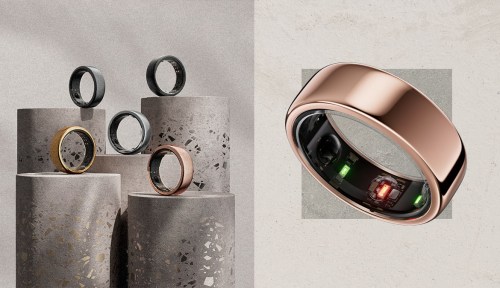
New year, same me. Just different goals. At the end of every year, I reevaluate my personal goals and made a pact to myself to get better quality sleep, incorporate more exercise, track my period, and decrease stress levels. Last year was tough, to say the least. The combination of spiraling thoughts, my distracting TikTok “for you” page (it’s filled with cooking tips and cute cat videos, if you must know), and occasional doomscrolling took a hit on my physical and mental health. Determined to prioritize my health and wellness with more intention in 2023 , I decided to test out the much talked-about Oura Ring Generation 3, which you may or may not have already seen on your social media feed.
Experts in This Article
New York City-based anti-aging and regenerative medicine doctor
exercise physiologist and certified personal trainer
Unlike other health tracking devices like a FitBit or Apple Watch, the Oura Ring is a health tracking wearable that delivers and records health metrics in real time. Using red infrared light beams, this tracker ring measures heart rate and body temperature to deliver personal data on quality and amount of sleep (which we tested separately in a story specifically about how the Oura Ring helped optimize our editorial commerce director’s sleep and, as a result, increased her performance at the gym), calories burned, oxygen saturation, period prediction, and more.
Oura, Gen 3 Ring — $349.00
Sizes available: 6-13, free sizing kit available
Colors: 5
How does the Oura Ring work?
According to Sharon Gam, PhD, CSCS, a personal trainer and health coach based in Orlando, Florida, the Oura Ring uses technology known as photoplethysmography (PPG). “Basically, the device uses light and light sensors to detect changes in blood flow,” says Dr. Gam. “The device sends light into the skin and measures how much light is reflected back from the tissues.” The light reflection is then used to detect tiny changes in blood flow to calculate heart rate. “It can also calculate breathing rates from that heart rate data because of a process called respiratory sinus arrhythmia,” adds Dr. Gam.
Using heart rate, the Oura Ring can track heart rate variability, aka the change in the time between each individual heartbeat. Since “heart rate variability is a good indicator of what’s going on with the central nervous system,” heart rate variability can deliver insights on whether you’re in a relaxed or stressed state, explains Dr. Gam. Changes in heart rate variability along with body temperature can be used to garner information about sleep, too.
Another notable metric that the Oura Ring tracks is blood oxygen. In short, blood oxygen levels can show how much oxygen is being carried to red blood cells. To track this metric, the Oura ring uses the same PPG technology, but the color of the light used in the ring—green or red—makes a huge difference. “Many devices use green light, which doesn’t penetrate very deeply into the skin. If red light is used, the light can penetrate deeper and measure more signals, including oxygen saturation,” says Dr. Gam. “The Oura ring uses red light.”
How does the Oura Ring compare to other health tracking devices?
Compared to laboratory-grade measurement devices and tests like electrocardiograms (ECG)—devices that record electrical signals from the heart—Oura Ring delivered comparable measurements in controlled conditions, per an Oura Ring-conducted study. Oura was found to have 99.9 percent reliability compared to medical-grade ECG for resting heart rate and 98.4 percent reliability compared to medical-grade ECG for heart rate variability. “Some of those studies were done or funded by the company, so it’s always a good idea to take those findings with a grain of salt, but overall it seems like the Oura Ring is pretty accurate,” says Dr. Gam.
Compared to a phone, a ring is much better, says Neil Paulvin, DO, an anti-aging and regenerative medicine doctor based in New York. “A ring in most cases is better than a phone since it has direct contact with the skin,” he says. While more research on the accuracy of the Oura Ring compared to heart rate monitor watches and phones needs to be conducted, all devices are subject to issues with accuracy during movement, per Dr. Gam. One 2020 study1 published in Plos One compared the accuracy of a chest-strapped ECG devices to PPG devices like a watch, earbuds, a ring (not Oura), and a forearm band during outdoor trail running. The study found that none of the PPG devices were accurate in measuring heart rate. So, it’s the best we’ve got right now—but it’s certainly not perfect.
While other wearables, including some sleep wearables, can also track heart rate and temperature, the Oura Ring does go beyond that and offers a “readiness” score, which is based on a variety of factors, like resting heart rate, HRV balance (this stands for heart rate variability, and it measures how or if the previous day’s activities impacted your body), body temp, sleep balance, recovery index (how long it takes your resting heart rate to stabilize while you sleep), and more. Under 70 means you’re not fully recovered, and the ring will suggest you take it easy that day (maybe fully relax, or get some recovery walking in), 70-84 is good, and 85 or higher means your body is ready to take on an intense workout.
Our senior commerce editor, Gina Vaynshteyn—who also has the Oura Ring—finds the readiness reading ultra helpful. “I’ve only become consistent about going to the gym in the last year, so I really have yet to learn when my body needs to recover. The Oura Ring can quantify when I need to rest, which is so important in my (and anyone’s fitness regimen),” Vaynshteyn says. Below is an example of a score that indicated she needed a rest day (this happened to be the day before she tested positive for COVID—the ring really did gauge her body’s readiness!).

Oura Ring review
Oura Ring setup
When I received my ring in the mail, which takes a few business days to deliver, the first thing I had to do was charge it. For my ring to fully charge, it took roughly 80 minutes for the very first charge and between 30 minutes to an hour for subsequent charges. Once my ring reached full battery life, I downloaded the Oura Ring app—which is compatible with iPhones and Androids—and paired my device to activate it.
All I needed to do was set up an account using my email and enter some personal information like height, weight, and date of birth. During set up, I was also asked what goals I wanted to work on, from managing stress levels to being more present and focused. The app delivers health metrics based on the parts of your health that you want to improve on.
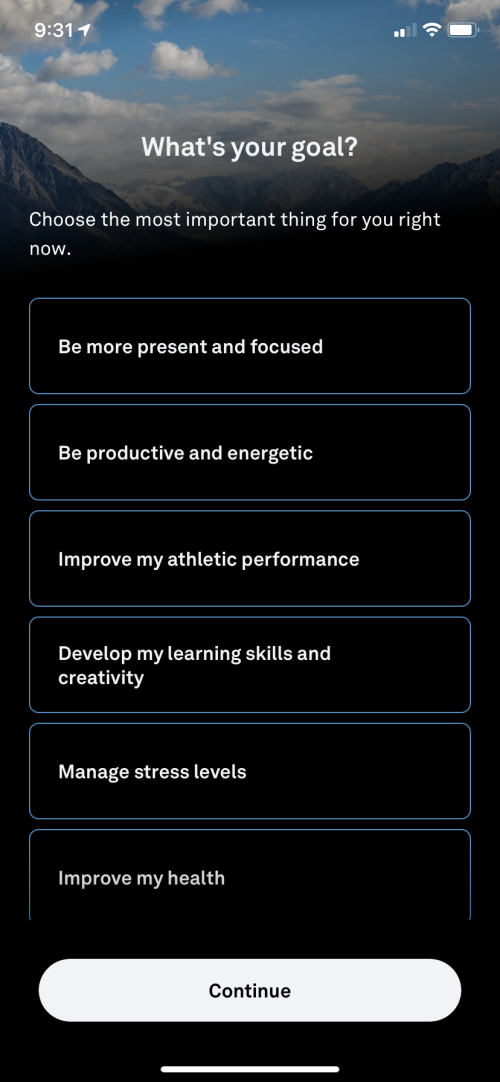
What does the Oura Ring measure?
Using red infrared light beams, the Oura Ring measures and tracks
- Sleep
- Heart rate
- Recovery
- Activity
- Stress levels
- Period prediction
- Blood oxygen
How does the ring look, feel, and fit?
Lightweight, the ring clocks in at just 0.1 pounds or three grams (I weighed it using my food scale) and is about the size of a quarter. It’s available in sizes six to 13 and in five colors: silver, black, matte black, gold, and rose gold.

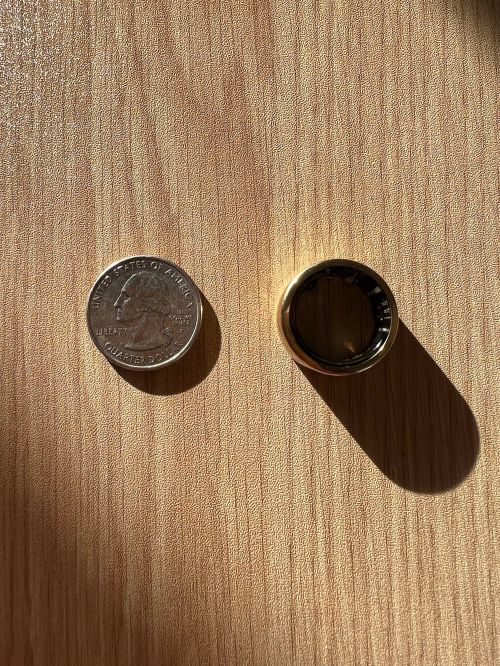
Compared to a regular ring, the Oura fits differently because it features three nodes with tracking technology underneath. To find my best size, I utilized Oura’s free sizing kit, which comes with 13 differently-sized rings for me to try before having the ring delivered.
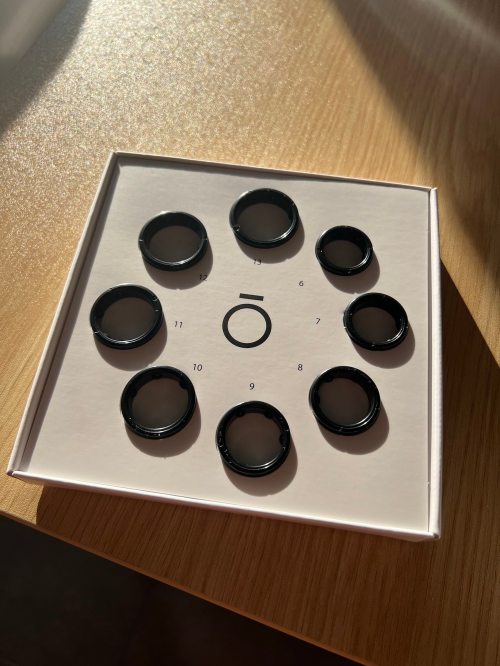
How has testing gone?
So far, I’ve been testing the ring for three months, and it’s been insightful. Using my resting heart, which usually ranges between 48 and 60, Oura delivers the data on how long I’ve slept, the time I’ve spent in various stages of sleep—awake, REM, light, and deep—and my heart rate. Considering these factors, I’m given a sleep score, ranging between 55 (not-so-great sleep) and 88 (good sleep). If I reached sufficient sleep, the app gives me a virtual high-five. If I’m lacking sleep, it sends me a notification that day to unwind to get a better night’s rest for the following day. Also nice? It tracks my movement during my snooze using a line system; the higher the line, the stronger my movement.
How the ring helps me get a better night’s snooze
The first thing I do when I wake up in the morning is check the Oura Ring app to look at my sleep score and time spent in slumber land—both of which makes me more cognizant of the fact that I need to turn off my electronics and get into bed earlier in the evening. What’s helpful is the app sends me a sleep recommendation to take it easy around 9 p.m.—every night. For me, unwinding looks like writing in my gratitude journal, taking a hot shower, and powering down my phone.
Over the past few months, I’ve experienced improvement in my sleep scores and sleep times. In the early days of using the ring, I was getting scores in the 50s and 60s and falling asleep at around 2 a.m. But having used it for three months now, I’m getting sleep scores in the 70s. I’m now in bed by 11 or 11:30 pm, and I feel less sluggish and more energized the next day.
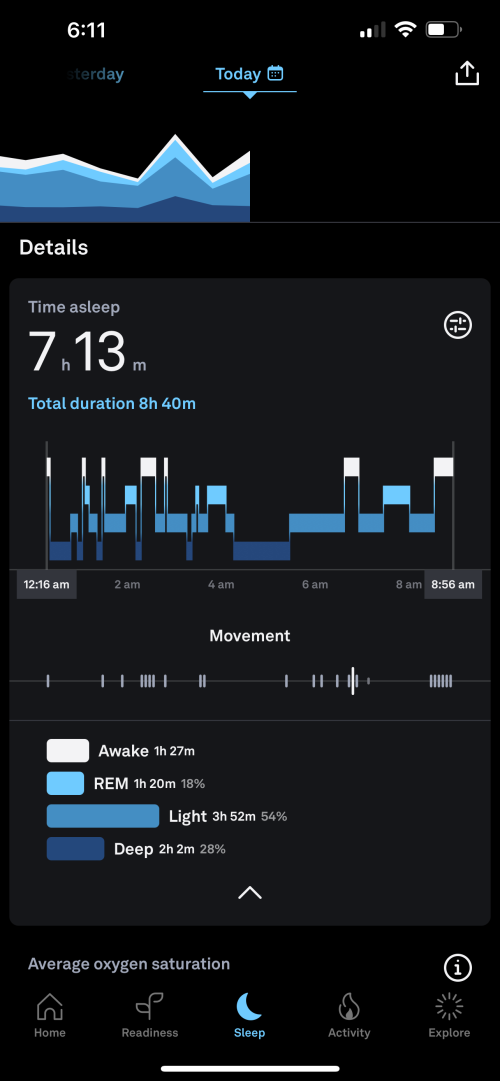
Period tracking
Using body temperature, the Oura Ring also predicts the exact (or at least, very close) day when my period is coming. As someone with a longer cycle and irregular period, the Oura has been a godsend, informing me what days I should be wearing a pad or my trusty pair of period underwear.
Activity tracking
Since I hit the gym four times per week, I love using the heart rate tracker and activity recorder. The ring tracks my beats throughout time and even delivers it in real-time, no matter if I’m walking or running. What’s cool is if I hold down the heart rate function, I can feel the beats per minute (neat, I know).When I’m working out, I record and time my runs and walks, both indoor and outdoor, on the app, all of which contribute to my activity score.
Since getting more physically active was a goal of mine, the app preset an activity goal of 350 calories. While I’m not meticulously tracking my calories on a daily basis, seeing this number enables me to plan my workouts to get in more movement throughout the day. For example, if my calorie burn is lower toward the end of the day (I go to the gym after 6 p.m.), I’ll hop on the treadmill for a 20 to 30-minute walk to ensure I’ve gotten in enough steps.
So far, I’ve reached my activity goal every day. One caveat to note: The app cannot track specific activities like jumping rope, lifting, and HIIT exercises, so I take the activity score with a grain of salt. It can only detect an elevated heart rate from those aforementioned activities. Vaynshteyn finds that it’s still effective when she uses it during Orangetheory (basically a HIIT class, but performance tracking is based on heart rate). It imports it from Apple Watch (yes, that’s two to three if you’re wearing the OTF heart rate monitor—wearables, but well-worth it if you’re curious about workout performance outside of just cardio). See below for how this tracking gets broken out in the app:

I can wear the ring for days at a time without a charge (between three and four days). However, once the battery levels dip to 30 percent, Oura recommends a charge, especially before bed. That’s because the sleep-tracking function uses a lot of horsepower. I like to charge my ring while I’m in the shower, sweeping my apartment, or washing the dishes.
Final thoughts
Well, the pros were right. The Oura Ring has the ability to give you the best health tracking results technology outside the doctor’s office can provide. It’s not perfect, but it’s pretty dang awesome. Before the Oura Ring, I didn’t track my health metrics because I didn’t like the idea of health tracking devices like watches, but the Oura Ring makes it possible to monitor my sleep, activity, and stress levels sans bulkiness. And since I wear jewelry on a daily basis, this ring fits right in as a piece of bling in my collection. I also love that it’s lightweight, is water-resistant up to 330 feet, and is simple in design.
As a weightlifter, I do find the ring bothersome during certain activities like assisted pull-ups and pull-downs, but I’ve learned to take off the ring during certain exercises (just remember to put it back on if you’re at the gym!). Other than that, I love having it on me to track my heart rate during treadmill sprints and runs. The Oura Ring Generation 3, the successor of the original Heritage Ring, retails for $349 in the silver and black colorways, $449 for stealth, $499 for gold, and $549 for rose gold. The silver and black colorways are similar in price to health tracking watches.
Having tested this ring for several months now, I don’t sleep or go about my day without it and foresee the Oura being in my health regimen for the long run (pun fully intended). It’s helped me stay more informed about my sleep habits and sculpt better practices for nighttime. The ring even helps me get in more physical activity by sending me notifications about moving around. I’d recommend this ring to all wellness and fitness enthusiasts and pros looking to get more shut-eye, track their stress levels, predict their periods, and be more informed about their body.
Editor’s note: While the Oura Ring is a great tool to use, always call your doctor or healthcare provider if you’re experiencing health concerns. The Oura Ring is a great supplemental device to use for everyday monitoring, but it shouldn’t replace visits to the doctor, nor can it diagnose illnesses.
FAQs
Is Gen 3 Oura worth it?
It depends on you and your lifestyle. “I think having access to their real-time health and fitness data can be a great tool to help people improve their health habits and motivate them to be more active and take better care of themselves,” says Dr. Gam. At the same time, some people may have trouble using that data objectively, and it can create unnecessary pressure, “so whether it’s right for someone is a personal decision,” she adds.
Is Oura Ring Gen 3 accurate?
“It’s pretty well-established that the sensors and technology that the Oura Rings use to collect data is accurate,” says Dr. Gam. One 2022 study2 found that the ring was accurate in assessing sleep and another concluded that it accurately measured resting heart rate3. It’s important to note that most studies have been conducted on generation 2 rings, so further testing would be needed to determine the accuracy of generation 3 rings.
Is an Oura Ring more accurate than an Apple Watch?
Per a 2022 study, the Oura Ring Gen 2 and Apple Watch were able to detect two-state sleep, aka REM (rapid eye movement) and NREM (non-rapid eye movement), but Oura outperformed Apple when it came to detecting wake epochs4, a period of wakefulness in a sleep cycle. Wake epochs are an important measurement because as they help researchers determine the duration and frequency of awakenings throughout the night.
When it comes to accurate heart rate measuring, “almost all fitness trackers have issues with accuracy during activity because movement causes problems with the sensors that measure heart rate, so I wouldn’t rely too heavily on either tracker to be able to accurately measure heart rate during exercise,” explains Dr. Gam.
Can I use Oura Ring 3 without a subscription?
Caroline Kryder, product manager and women’s health lead at Oura, tells W+G that without a membership, the Oura Ring Gen 3 can only be used with limited functionality. “You’ll be able to see your three daily Oura scores (readiness, sleep, and activity), ring battery, basic profile information, app settings, and the explore tab. With the Oura membership, users have access to in-depth sleep analysis, live and accurate heart rate monitoring, body temperature readings for early illness detection and period prediction, heart rate tracking during workouts, and daily, weekly, and monthly health trends.
Does Oura have a monthly fee?
Yes, the monthly fee is $5.99 (USD), according to Kryder. New customers who purchase an Oura ring will receive one free month of Oura membership.
- Navalta, James W et al. “Concurrent heart rate validity of wearable technology devices during trail running.” PloS one vol. 15,8 e0238569. 31 Aug. 2020, doi:10.1371/journal.pone.0238569↩︎
- Cao, Rui et al. “Accuracy Assessment of Oura Ring Nocturnal Heart Rate and Heart Rate Variability in Comparison With Electrocardiography in Time and Frequency Domains: Comprehensive Analysis.” Journal of medical Internet research vol. 24,1 e27487. 18 Jan. 2022, doi:10.2196/27487↩︎
- Henriksen, André et al. “Polar Vantage and Oura Physical Activity and Sleep Trackers: Validation and Comparison Study.” JMIR formative research vol. 6,5 e27248. 27 May. 2022, doi:10.2196/27248↩︎
- Miller, Dean J et al. “A Validation of Six Wearable Devices for Estimating Sleep, Heart Rate and Heart Rate Variability in Healthy Adults.” Sensors (Basel, Switzerland) vol. 22,16 6317. 22 Aug. 2022, doi:10.3390/s22166317↩︎
Sign up for the Well+Good SHOP Newsletter
Get exclusive deals on wellness, beauty, fitness, and food products that have been hand-picked by our editors.
Got it, you've been added to our email list.








